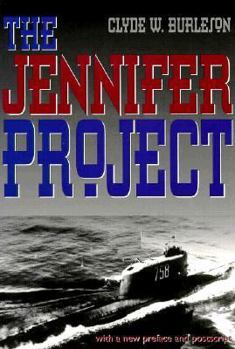The Jennifer Project
Select Format
Select Condition 
Book Overview
In 1968 a Soviet G-class submarine mysteriously exploded and sank to the bottom of the Pacific. With Cold War secrecy and speed, U.S. military intelligence raced to find a way to raise the sub. In the new preface to this edition of The Jennifer Project, which was first published in 1977, author Clyde Burleson discusses some of the sources he could not reveal twenty years ago and provides an interesting swords-to-plowshares update. In one of the more remarkable episodes of high-tech espionage and engineering of the Cold War, the effort to raise the Soviet sub, code-named the "Jennifer Project," assembled a cast of players that included top military brass, the CIA, and the eccentric millionaire and inventor Howard Hughes. The Project was a monumental effort to create a tool that could reach three miles below the ocean's surface and pull the sub from primordial muck--in secret. Financed and built by Hughes and Global Marine under contract with the CIA, the ship created to pluck the sub from the ooze was a technological marvel. Two football fields in length and twenty-three stories high, the Hughes Glomar Explorer held in its hull a six-million-pound submersible "claw" for picking up sections of the submarine. The project cost the U.S. government hundreds of millions of dollars, but the intelligence community was betting that, if successful, reclamation of the Soviet submarine would mean accessing invaluable military knowledge as the two superpowers neared negotiations in the Strategic Arms Limitation Treaty talks. The Jennifer Project revisits a fascinating period of high-level intrigue and invention that has remained unknown to many Americans.
Format:Paperback
Language:English
ISBN:0890967644
ISBN13:9780890967645
Release Date:June 1997
Publisher:Texas A&M University Press
Length:180 Pages
Weight:0.70 lbs.
Dimensions:0.5" x 6.1" x 9.0"
Customer Reviews
1 rating
The greatest deep-sea salvage mission of all time.
Published by Thriftbooks.com User , 26 years ago
The Jeniffer Project tells, documentary-style, of the most difficult deep-sea salvage mission of all time, the CIA's effort to raise a Russian missile submarine that sank 750 miles northwest of Hawaii in 1968. Political infighting between the White House, the Pentagon, and a few select members of Congress changed a mission that was to be accompolished by small remote submarines (ala Bob Ballard/Titanic) to one which spent in excess of $200 million dollars to research, design, and built the Glomar Explorer, a one-of-a-kind salvage ship under the cover story that it was to be used by Howard Hughes to mine the world's oceans. Other books since the origional 1977 publication have shed more light on the story ("Spy Sub" & "Blind Man's Bluff" for example) of how involved the salvage mission really was. Most reports say the mission was a failure, and only part of the submarine was recovered. But one question has yet to be answered: If the submarine was to be brought up in one piece, as nearly every story written about it has stated, how then does one pull a 300+ foot-long sub up through an opening of 199 feet, which was the length of the "moon pool" in the bottom of the Glomar Explorer. A very good docu-story.






